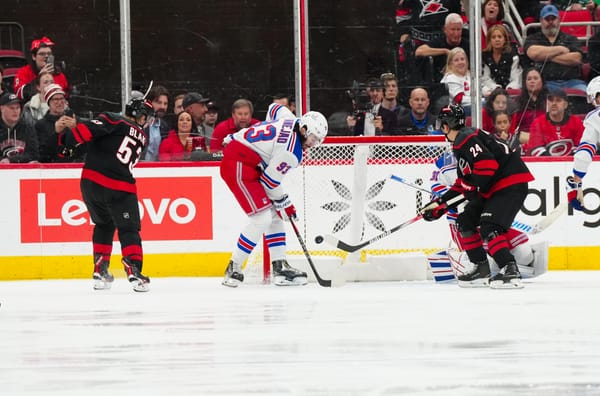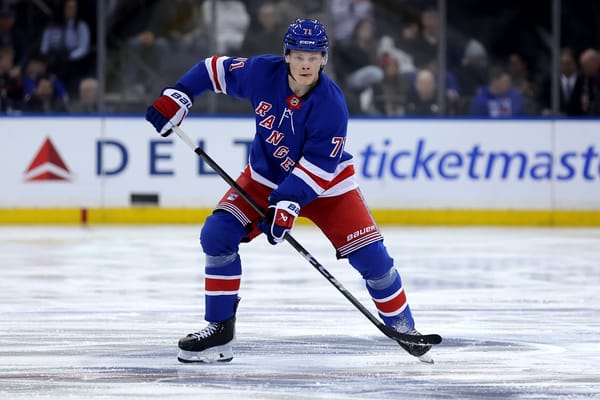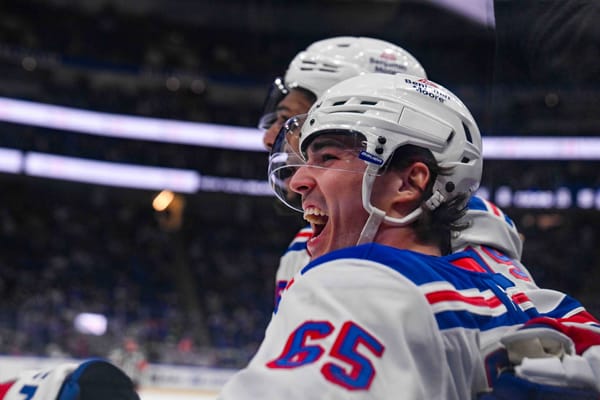Lessons To Be Learned From Rangers’ 2004 Fire Sale
The Rangers can’t afford to bungle being sellers like they did in 2004.
As the 2018 trade deadline approaches all signs point to the New York Rangers being sellers. The last time we saw the front office accept reality and clear the cupboards was 2004. Interestingly enough, the man who attempted the last rebuild is still in the Rangers front office.
Glen Sather inherited the role of general manager from Neil Smith in June 2000. It was a job that came with plenty of prestige and Scrooge McDuck levels of capital, but also a great deal of pressure. The moves that Sather made in his first few years illustrate just how badly the Rangers wanted to avoid biting the bullet and committing to a rebuild after three years of missing the playoffs with an aging roster.
‘’We were trying to rebuild since the first day I got here, while at the same time trying to be competitive on the ice at the NHL level,’’ Sather said after trading Leetch.
Prior to the fire sale of 2004 Sather traded for Pavel Bure, Eric Lindros, Jaromir Jagr, Alexei Kovalev, Mike Dunham, and Tom Poti. He also signed big ticket free agents like Bobby Holik and Darius Kasparaitis. The result of all those blockbuster deals and big contracts? The Rangers failed to qualify for the playoffs for four consecutive years before admitting defeat in March of 2004.
‘’Anyone that’s a Ranger fan or a Ranger is obviously disappointed the last seven years,’’ Mark Messier said after the smoke cleared on deadline day 2004. ‘’To see it unfold the way it has and to see Brian traded in the end, I guess it’s bottomed out.’’
The 2003-04 season ended up being Messier’s last and it was the end of an era. The 2004-05 lockout only prolonged the mourning period for the Garden Faithful.
Then, against all expectations, the Rangers emerged from the lockout as a completely new team. Led by a resurgent Jagr, a cadre of European veterans and a young goalie named Henrik Lundqvist, the Blueshirts made it to the playoffs. Since then the Rangers have appeared in the playoffs ten more times, including a trip to the Stanley Cup Final in 2014.
So, how much of the Rangers’ success in the Lundqvist era is owed to Sather’s 2004 fire sale? As it turns out, alarmingly little.
Sather made 11 trades (only the highlights are listed above) on or before the 2004 deadline. As a direct result of selling Kovalev, Leetch, Nedved, Barnaby, Malakhov, de Vries, and Rucinsky the Rangers had 13 picks in the 2004 Draft (remember, there were nine rounds that year) and a handful of intriguing prospects.
“I thought the time was right to move forward and speed up the rebuilding process,” Sather said. “You have to start with a nucleus of players who have grown up in your organization.”
So, what the heck happened?
Assets acquired at 2004 trade deadline
| Player | P | NHL GP | NYR GP | Notes |
|---|---|---|---|---|
| Jozef Balej | W | 18 | 13 | 21-year-old prospect (3rd round) | Dealt to VAN for F. Fedorov, 2005 (3 GP w/NYR) |
| Bruce Graham | C | 0 | 0 | |
| Jarkko Immonen | C | 20 | 20 | 22-year-old prospect (8th round) |
| Maxim Kondratiev | D | 40 | 29 | 21-year-old prospect | Dealt to ANA for P. Sykora plus, 2006 |
| Mike Sauer | D | 98 | 98 | Career ended by concussion |
| Lauri Korpikoski | W | 609 | 68 | Dealt to ARI for E. Lisin, 2009 |
| Jonathan Paiement | D | 0 | 0 | 158 career AHL games |
| Dwight Helminen | W | 27 | 0 | 22-year-old (8th round) | Left NYR as free agent |
| Steve Valiquette | G | 46 | 39 | |
| Dane Byers | W | 14 | 6 | Dealt to CBJ for C. Kolarik, 2010 |
| Blair Betts | C | 477 | 304 | 24-year-old | Left NYR as free agent |
| Jamie McLennan | G | 254 | 4 | 32-year-old | Left NYR as free agent |
| Greg Moore | W | 10 | 6 | 21-year-old prospect (5th round) | Left NYR as free agent |
| Chris McAllister | D | 301 | 12 | 28-year-old, NHL career ended 2005 |
| Zdenek Bahensky | D | 0 | 0 | 13 career AHL games |
| Brandon Dubinsky | C/W | 723 | 393 | Active NHL player with CBJ |Traded in 2013 |
| Billy Ryan | W | 0 | 0 | |
| David Liffiton | D | 7 | 3 | 21-year-old prospect (2nd round), 318 AHL GP |
| Rick Kozak | W | 0 | 0 | 3 AHL games with Hartford |
| Marc Staal | D | 739 | 739 | Active NYR player |
| Karel Rachunek | D | 371 | 78 | 24-year-old | Left NYR as free agent |
| Alexandre Giroux | W | 48 | 1 | 24-year-old | Left NYR as free agent |
| R.J. Umberger | C/W | 779 | 0 | 22-year-old prospect | Left NYR as FA | NYR receive 2nd round pick (used to acquire Korpikoski) |
| Martin Grenier | D | 23-year-old prospect | Left NYR as free agent |
Only four of the Rangers 13 draft picks in 2004 played more than 15 NHL games. And just two of those four were players acquired as a result of March 2004’s fire sale (Lauri Korpikoski and Brandon Dubinsky). The rest failed because of poor scouting, poor development, or a combination of the two.
Of course we will never know what could have been in regards to Mike Sauer, but even if he emerged as a stalwart second pair defenseman he still would have been a poor return for Leetch.
Marc Staal, Rick Nash, and Pavel Buchnevich are the three active Rangers with ties to Sather’s great giveaway. In 2012 Sather turned Dubinsky, Artem Anisimov, Tim Erixon, and a 2013 first round pick into Nash and a third round pick that became Buchnevich. And in 2005 the Rangers traded up for Staal much like they did for Korpikoski the year before.
So, what does all of this tell us? The 2004 Draft, like so many drafts that came before and after it, revealed just how important the imperfect science of scouting is.
The Blueshirts had six picks in the first two rounds that year, but only one of them — Dubinsky — became a part of Sather’s “nucleus” after the lockout. Sather and the Rangers passed over players like Mike Green, Travis Zajac, Alex Radulov, Alex Goligoski, David Krejci, Alexander Edler, and others. The Rangers weren’t the only team to miss out that draft, but blowing it with that many whacks at the piñata was a huge organizational failure.
The fallout of 2004 also illustrates the risks of putting too many chips on prospects and younger players that other teams are willing to cough up. This is why post-draft scouting is so important and why teams today spend so much time, treasure and energy following the progress of prospects outside of their own organizations.
Sather acquired a dozen players under the age of 25 at the 2004 deadline, but only a 24-year-old Blair Betts (a former second round pick) ended up making a positive impact. Karel Rachunek had a good season in New York, but left the team as a free agent. Jarkko Immonen and Jozef Balej were disasters.
In the coming days and weeks Jeff Gorton should spend a lot time reflecting on how the Rangers failed at the 2004 trade deadline. He is in a less dire situation than Sather was then, but Gorton still has crucial decisions to make as a GM who is ready to sell after admitting defeat. But, unlike Sather, Gorton is unlikely to succeed in spite of poor returns for key assets and poor drafting. He doesn’t have an ace waiting up his sleeve like Sather did with Lundqvist. What Gorton does have is experience building a team through the draft.
Prior to joining the Rangers, Gorton worked for the Bruins starting in 1992 and he became director of scouting information in 1994. He then progressed to assistant general manager. He is credited for running the 2006 draft which landed the Bruins Phil Kessel, Milan Lucic, Brad Marchand, and Tuukka Rask via a trade of Andrew Raycroft on draft day. In the simplest of terms, Gorton has a background of identifying talent and in 2018 he has more resources than Sather did in 2004.
Gorton needs to get this right. The Rangers can’t afford to bungle the imminent trades of Nash, Grabner, McDonagh, and Zuccarello.




